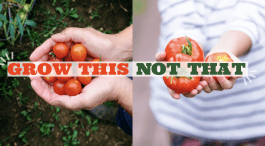
When it comes to starting a vegetable garden, the options can seem overwhelming. With so many delicious and nutritious vegetables to choose from, it can be challenging to know where to begin. While all vegetables offer health benefits, some are easier to grow and provide a higher nutrient density than others. In this article, I’m taking a lighthearted approach to compare common garden vegetables, highlighting the “Grow This” options that are both easy to cultivate and pack a nutritional punch.
It’s important to note that all the vegetables mentioned in this article are valuable additions to a healthy diet. Each vegetable offers a unique set of vitamins, minerals, and antioxidants that contribute to overall well-being. The “Not That” options are not necessarily unhealthy or unworthy of a spot in your garden; they simply may require more effort to grow or have a slightly lower nutrient profile compared to their “Grow This” counterparts.
By focusing on the “Grow This” vegetables, you’ll be able to create a thriving garden that yields a bountiful harvest of nutrient-dense produce. These vegetables are generally easier to grow, more resilient to pests and disease, and offer a higher concentration of beneficial compounds. However, don’t feel discouraged from experimenting with the “Not That” options if you have the space and resources. Gardening is a rewarding and educational experience, and every vegetable you grow is a step towards a healthier, more sustainable lifestyle.
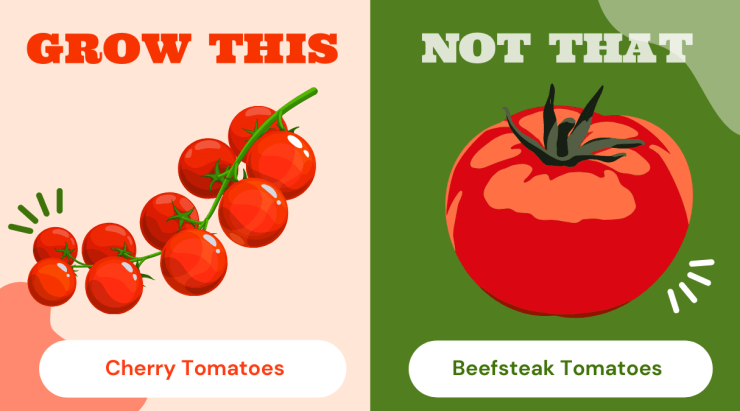
Grow This: Cherry Tomatoes
Not That: Beefsteak Tomatoes
Cherry tomatoes are the superior choice compared to beefsteak tomatoes for many reasons. Not only are they prolific producers that contain higher concentrations of the powerful antioxidant lycopene, but they’re also easier to grow and less prone to cracking than larger beefsteak varieties. Cherry tomatoes have the added advantages of faster maturity, taking only 50-65 days to harvest compared to 80+ days for beefsteaks. Their compact growth habit makes them more suitable for growing in containers and small spaces. Cherry tomatoes boast a higher sugar content and sweeter flavor than many beefsteak types. They tend to be more resistant to common tomato diseases and pests, and produce abundant clusters of fruit all season long. Trellising or staking cherry tomatoes is easier, which improves airflow and reduces disease issues. They rarely suffer from catfacing, uneven ripening, or other deformities that often affect beefsteaks. Cherry tomatoes require less pruning and maintenance to stay productive. They also hold well on the vine without splitting, providing a longer window for picking. For an easy, productive, and delicious tomato crop, cherry varieties are the optimal choice over large, finicky beefsteaks. You’ll be rewarded with baskets of sweet, healthy cherry tomatoes all summer long with minimal effort.
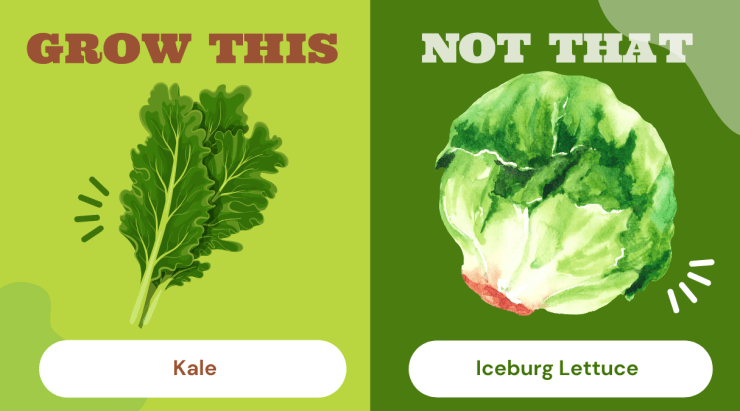
Grow This: Kale
Not That: Iceberg Lettuce
Kale is a nutrient-dense leafy green that’s easy to grow and packed with vitamins A, C, and K. It’s also more resilient than iceberg lettuce, which has a high water content but lacks nutrient density.
Kale is a hardier plant that can withstand cooler temperatures and even a light frost, making it an excellent choice for extending your gardening season. It’s less prone to bolting (prematurely going to seed) in hot weather compared to lettuce. Kale is also more pest-resistant, especially when compared to tender lettuces that often fall victim to aphids and other insects. A single kale plant can provide an ongoing harvest for months, as the leaves grow back after being picked. In contrast, iceberg lettuce is typically harvested once and then needs to be replanted. Kale also has greater culinary versatility – it can be enjoyed raw in salads, blended in smoothies, sautéed, or added to soups and stews. Its sturdy texture holds up well when cooked. Iceberg lettuce, on the other hand, is really only suitable for raw consumption in salads and on sandwiches or burgers. When it comes to nutrition, there’s no comparison – kale is one of the most nutrient-dense foods available, while iceberg lettuce is mainly water and fiber, offering little in the way of vitamins or minerals.
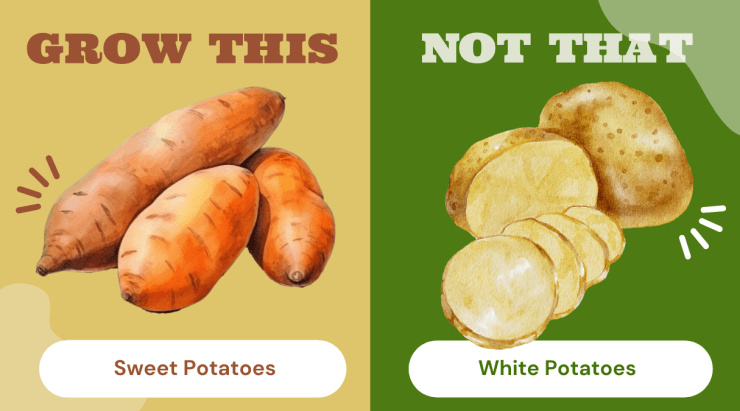
Grow This: Sweet Potatoes
Not That: White Potatoes
Sweet potatoes are a nutritious and storage-friendly root vegetable. They’re rich in beta-carotene, vitamin C, and fiber, and they’re less susceptible to pests and disease compared to white potatoes.
Sweet potatoes are also easier to grow than white potatoes. They thrive in warm weather and can be planted directly in the garden after the last frost. Sweet potatoes are drought-tolerant and can grow well even in poor soil, as long as it is well-drained. They require less fertilization than white potatoes and are not as heavy feeders. Sweet potato vines also make an attractive groundcover, with their lush, trailing foliage. When it comes to pests and diseases, sweet potatoes are less prone to issues like potato blight, scab, and Colorado potato beetles that often plague white potatoes. Sweet potatoes can be harvested as needed over a longer period, while white potatoes are typically harvested all at once. After harvesting, sweet potatoes store well for several months in a cool, dry place, making them an excellent option for winter food storage. Culinarily, sweet potatoes are versatile and can be baked, roasted, mashed, or added to soups and stews, offering a nutritious and flavorful alternative to white potatoes.

Grow This: Rainbow Chard
Not That: Spinach
Rainbow chard is a colorful and hardy leafy green that’s rich in vitamins A, C, and K, as well as magnesium and potassium. It’s also more heat-tolerant than spinach, making it a reliable choice for summer gardens. Did you also know that it’s only a myth that spinach is high in iron? It’s based on a misprint! The iron in spinach is also non-heme iron, which isn’t absorbed very well.
Another win for Rainbow chard is that it’s easier to grow than spinach in several ways. It is a biennial plant, meaning it has a two-year life cycle, compared to spinach which is an annual. This allows chard to be harvested over a longer period, as it will continue producing leaves even after the first year. Chard is also more tolerant of a wider range of temperatures, growing well in both cool and warm weather. It is less likely to bolt (go to seed) in hot temperatures compared to spinach, which tends to bolt quickly in the heat. Chard is also more pest-resistant than spinach, which can be susceptible to leaf miners and other insects. When it comes to nutrition, while both chard and spinach are nutrient-dense, chard contains higher levels of vitamins C and A, as well as antioxidants like beta-carotene. The colorful stems of rainbow chard also contain betalains, which are beneficial phytonutrients with antioxidant and anti-inflammatory properties.
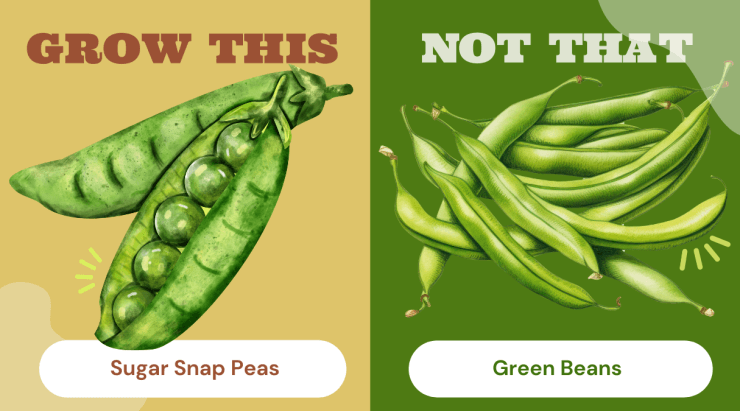
Grow This: Sugar Snap Peas
Not That: Green Beans
Sugar snap peas are a low-calorie, high-fiber vegetable that can be enjoyed raw or lightly cooked. They’re easier to grow than green beans and offer a sweeter, more satisfying crunch.
Sugar snap peas are also more versatile in the garden compared to green beans. They can be planted earlier in the season, as they tolerate cooler temperatures better than green beans. Sugar snap peas have a shorter growing period, typically being ready to harvest in 50-60 days, while green beans can take 60-70 days. Sugar snap peas are also less prone to common bean pests and diseases, such as bean beetles and mosaic virus. Nutritionally, sugar snap peas are higher in vitamin C and folate compared to green beans. They also contain more plant-based protein and iron. The entire pod of sugar snap peas is edible, and can be eaten raw. Green beans should be blanched at a minimum, to avoid stomach upset. This means less preparation time and waste with sugar snap peas. Their sweet flavor and crisp texture make them a kid-friendly snack and a delightful addition to salads, stir-fries, and other dishes.
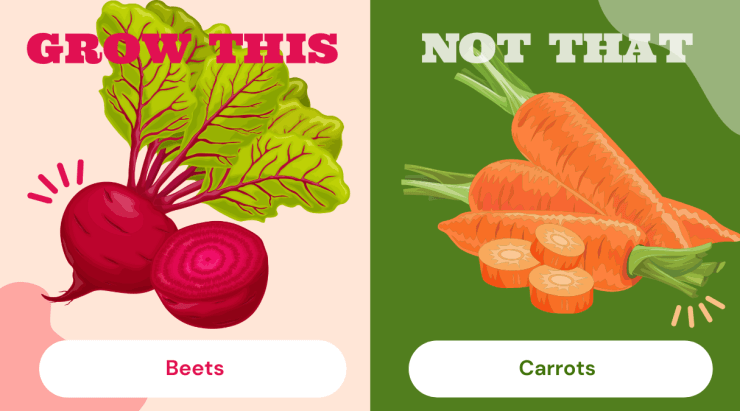
Grow This: Beets
Not That: Carrots
Beets are a nutrient powerhouse and are generally easier to grow than carrots. They’re rich in folate, manganese, and potassium, and their leaves can also be eaten for an extra nutrient boost. Beets are more tolerant of a wider range of soil types and temperatures compared to carrots – they can grow in heavier, clayey soils that would cause carrots to fork or become misshapen. Beets germinate more easily and have a higher success rate than carrots, which can be fussy about moisture levels and soil temperature. When it comes to pests and diseases, beets are less susceptible to issues like carrot rust fly and nematodes that often affect carrots. Beet greens are nutritious and can be harvested throughout the growing season, while carrot greens are not typically consumed, though they can be, and are a nutritious addition to stocks. Beets are higher in several key nutrients compared to carrots, including folate, manganese, potassium, and magnesium. They also contain unique antioxidants called betalains, which have anti-inflammatory and detoxification properties. Beets’ sweet, earthy flavor and vibrant color make them a versatile ingredient in dishes ranging from salads to soups to baked goods.
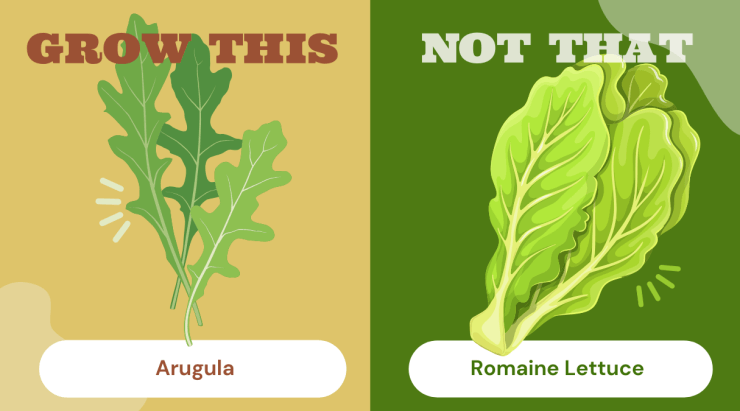
Grow This: Arugula
Not That: Romaine Lettuce
Arugula is a fast-growing, peppery green that’s packed with vitamins A, C, and K. It’s more resilient than romaine lettuce and adds a bold flavor to salads and sandwiches.
Arugula is easier to grow than romaine lettuce in several ways. It has a shorter growing time, taking only 30-40 days from seed to harvest, while romaine lettuce can take 60-80 days. Arugula is more tolerant of temperature fluctuations and can be grown in both cool and warm weather. It’s less prone to bolting in the heat compared to romaine lettuce, which tends to bolt quickly in hot temperatures. Arugula is also more pest-resistant than romaine lettuce, which can be susceptible to aphids, thrips, and other insects. When it comes to nutrition, arugula contains higher levels of calcium, potassium, and folate compared to romaine lettuce. It’s also a good source of antioxidants like beta-carotene and vitamin C. Arugula’s peppery, slightly spicy flavor adds a unique dimension to dishes, making it a popular choice for salads, sandwiches, pizzas, and pasta dishes. It can be harvested as baby greens for a milder flavor or allowed to mature for a bolder taste. Arugula is also more versatile in the garden, as it can be grown in containers, raised beds, or directly in the ground, and my favorite perk is that it can be succession planted for a continuous harvest throughout the growing season.
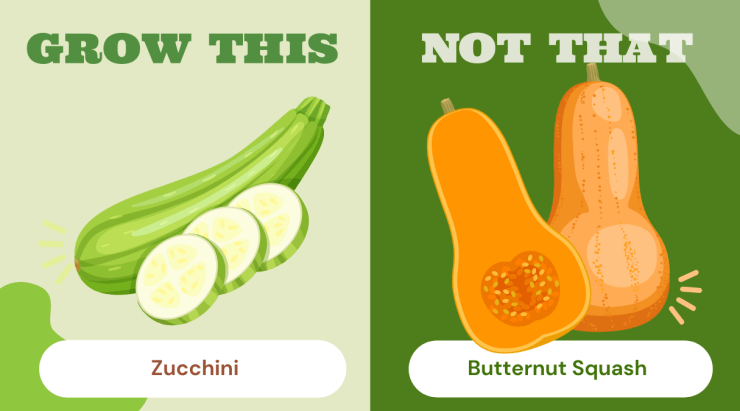
Grow This: Zucchini
Not That: Butternut Squash
Zucchini is a prolific summer squash that’s easy to grow and packed with vitamin C, potassium, and fiber. It’s also more compact and faster to mature than butternut squash, making it a great choice for small gardens.
Zucchini plants are more adaptable and require less maintenance compared to butternut squash. They can be grown in a variety of soil types and are less demanding in terms of fertility and water requirements. Zucchini plants have a bush growth habit, making them suitable for growing in containers or small spaces, while butternut squash requires more room to sprawl. Zucchini is also more disease-resistant than butternut squash, which can be prone to powdery mildew and vine borers. When it comes to harvesting, zucchini can be picked at a smaller size, typically around 6-8 inches long, allowing for a more continuous harvest throughout the growing season. Butternut squash, on the other hand, needs to fully mature on the vine and is usually harvested all at once in the fall. Nutritionally, zucchini is lower in calories and carbohydrates compared to butternut squash, making it a good choice for those watching their calorie/carb intake. Zucchini is also a good source of antioxidants like lutein and zeaxanthin, which are important for eye health. Its mild flavor and soft texture make it a versatile ingredient that can be used in a variety of dishes, from salads and stir-fries to baked goods and pasta sauces.
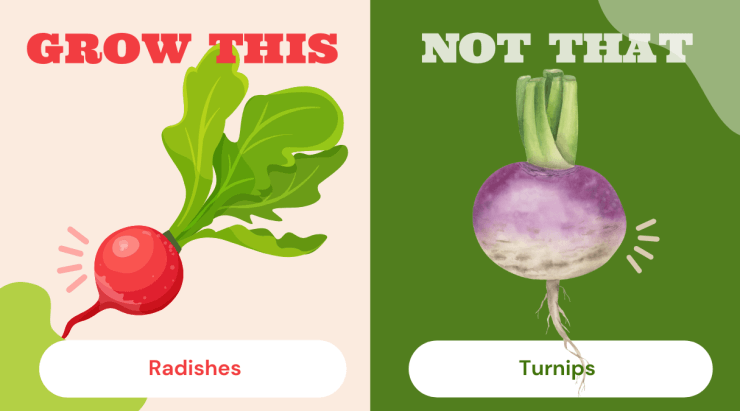
Grow This: Radishes
Not That: Turnips
Radishes are one of the fastest-growing vegetables and are rich in vitamin C and antioxidants. They’re also easier to grow than turnips and add a spicy kick to salads and slaws.
Radishes are more adaptable and can be grown in a wider range of soil types and temperatures compared to turnips. They have a shorter growing time, with some varieties ready to harvest in as little as 20-30 days, while turnips typically take 50-60 days to mature. Radishes are also more space-efficient, as they can be grown closely together and don’t require as much room as turnips. They are less prone to pests and diseases, such as flea beetles and root maggots, which can be problematic for turnips. Radishes are more versatile in terms of planting times, as they can be grown in both cool and warm seasons, and can be succession planted for a continuous harvest. Turnips, on the other hand, are best grown in cooler weather and can become woody and bitter if grown in hot temperatures. When it comes to nutrition, radishes are lower in calories and carbohydrates compared to turnips. They are a good source of vitamin C, folate, and potassium, as well as antioxidants like anthocyanins and glucosinolates.
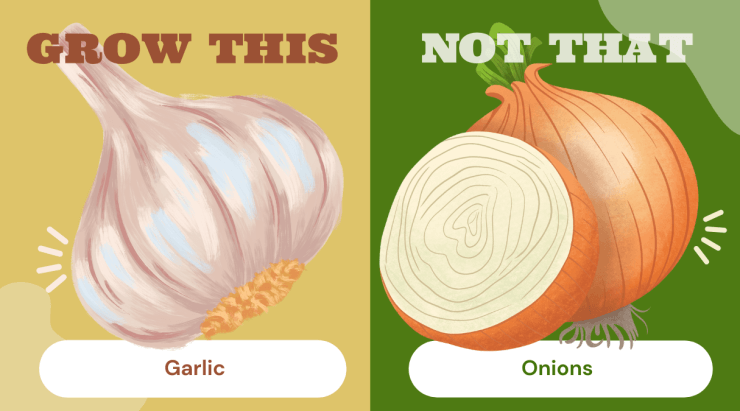
Eat This: Garlic
Not That: Onions
Garlic is known for its immune-boosting and anti-inflammatory properties, thanks to its high content of allicin. It’s also been linked to lower cholesterol and blood pressure levels. While onions are also healthy, garlic packs a more potent nutritional punch.
Garlic is easier to grow than onions in several ways. It is a perennial plant, meaning it can be grown year after year without having to be replanted, while onions are typically grown as annuals. Garlic requires less space than onions, as each clove planted will produce a single bulb, while onion sets or seeds need to be planted more closely together to produce a larger yield. Garlic is also more tolerant of a wider range of soil types and is less demanding in terms of fertility compared to onions. It is less susceptible to pests and diseases, such as thrips and downy mildew, which can be problematic for onions. Garlic can be planted in the fall for a summer harvest or in early spring for a late summer harvest, providing more flexibility in planting times. When it comes to storage, garlic has a longer shelf life than onions, as it can be kept for several months in a cool, dry place without sprouting or deteriorating. Garlic’s strong flavor and aroma make it a versatile ingredient in many dishes, from pasta sauces and stir-fries to roasted vegetables and salad dressings. It can also be used medicinally, as it has antimicrobial and antiviral properties that can help boost the immune system and fight off infections.
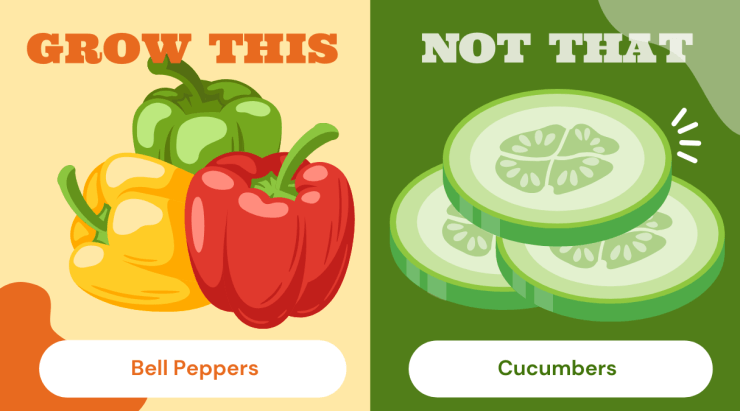
Eat This: Bell Peppers
Not That: Cucumbers
Ah yes, our favorite fresh salad add-ins—what a duel! Bell peppers, particularly red and yellow varieties, are loaded with vitamins A and C, as well as antioxidants like capsanthin and violaxanthin. They’re also a good source of fiber. Cucumbers, while hydrating and low in calories, don’t offer the same level of nutrients as bell peppers.
Bell peppers are also easier to grow than cucumbers in several aspects. Bell peppers are self-pollinating, meaning they don’t require pollination by insects or manual intervention, unlike cucumbers which rely on pollination for fruit set. Peppers are also less prone to certain pests and diseases that commonly affect cucumbers, such as cucumber beetles, powdery mildew, and downy mildew. When it comes to yield, a single bell pepper plant can produce a prolific harvest of 5-10 fruits per plant, while cucumber plants may produce more fruits but require more space and resources. Bell peppers have a longer shelf life than cucumbers and can be stored for 1-2 weeks in the refrigerator, while cucumbers tend to deteriorate more quickly. Nutritionally, bell peppers are higher in several key vitamins and minerals compared to cucumbers, including vitamin C, vitamin A, folate, and potassium. They also contain a range of antioxidants and phytochemicals that have been linked to various health benefits, such as improved eye health, reduced inflammation, and lower risk of certain cancers.
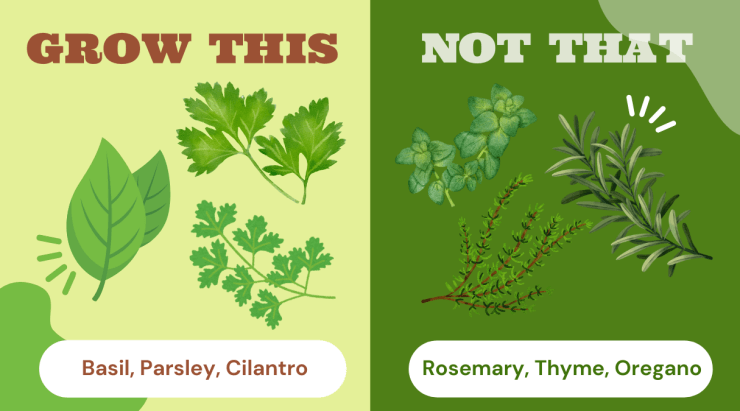
Grow This: Herbs (Basil, Parsley, Cilantro)
Not That: Herbs (Rosemary, Thyme, Oregano)
While all herbs are worth growing, some are easier than others. Basil, parsley, and cilantro are fast-growing, annual herbs that are rich in vitamins and antioxidants. Rosemary, thyme, and oregano are perennial herbs that can be more challenging to grow and have a stronger, more pungent flavor.
Basil, parsley, and cilantro are also more adaptable to different growing conditions compared to rosemary, thyme, and oregano. They can be grown easily from seed and thrive in a wider range of soil types and temperatures. These annual herbs grow quickly and can be harvested throughout the growing season, providing a continuous supply of fresh herbs. They are less susceptible to pests and diseases, making them easier to maintain for novice gardeners.
On the other hand, rosemary, thyme, and oregano are woody, perennial herbs that require more specific growing conditions. They prefer well-draining soil and can be sensitive to overwatering and humidity. These herbs are often propagated through cuttings or division, which can be more challenging than starting from seed. They have a slower growth rate and may take longer to establish in the garden.
When it comes to nutrition, basil, parsley, and cilantro are rich in vitamins K, A, and C, as well as antioxidants like beta-carotene and lutein. They are also good sources of minerals like iron, calcium, and magnesium. While rosemary, thyme, and oregano also contain beneficial nutrients and compounds, they are typically used in smaller amounts due to their strong flavors.
In terms of culinary uses, basil, parsley, and cilantro are versatile herbs that can be used fresh in a variety of dishes, from salads and sandwiches to pasta and stir-fries. Rosemary, thyme, and oregano are more commonly used as dried herbs and are best suited for heartier dishes like roasts, stews, and soups.
Agree? Or agree to disagree?
By choosing to grow these nutritious and easy-to-cultivate vegetables and herbs, you’ll be setting yourself up for a successful and healthy harvest. Remember, gardening is a learning process, so don’t be afraid to experiment and try new things.
Happy gardening and healthy eating! And remember, take this article lightly – all plants are worthy of growing! What are your favorites to grow?


 Previous
Previous

